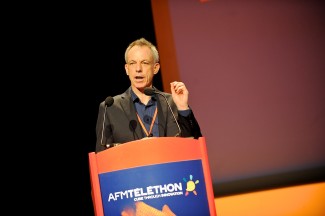Wednesday opened on a symposium based on the development of innovative therapies, which make a new, booming type of medicine. Because the first drug candidates developed so far are only “prototypes”, researchers and doctors are building a strategy to tackle the disease on all fronts.
 Matthew Wood from Oxford University (UK) restored the expression of dystrophy of mdx mice thanks to a new generation of peptides improving exon skipping and allowing a more efficient targeting of a wide number of tissues in the organism, such as the heart or the central nervous system… Aurélie Goyenvalle from the University of Versailles Saint-Quentin also developed a pharmacogenomics approach using a new antisens oligonucleotide which was successfully tested on mice. Caroline Le Guiner from Atlantic Gene Therapies (Nantes) presented the results of her work on gene therapy on GRMD dogs, a Duchenne muscular dystrophy model. Two different treatments based on the use of AAV vectors are being developed.
Matthew Wood from Oxford University (UK) restored the expression of dystrophy of mdx mice thanks to a new generation of peptides improving exon skipping and allowing a more efficient targeting of a wide number of tissues in the organism, such as the heart or the central nervous system… Aurélie Goyenvalle from the University of Versailles Saint-Quentin also developed a pharmacogenomics approach using a new antisens oligonucleotide which was successfully tested on mice. Caroline Le Guiner from Atlantic Gene Therapies (Nantes) presented the results of her work on gene therapy on GRMD dogs, a Duchenne muscular dystrophy model. Two different treatments based on the use of AAV vectors are being developed.
During the parallel symposium “Myotonic dystrophy”, Bernard Jasmin from the University of Ottawa (Canada) presented his works to identify binding proteins playing a key role within the skeletal muscle, especially Staufen1 binding protein. Studies show that Staufen1, which mounts up at the level of the neuromuscular junction’s post-synaptic membrane, is a key protein influencing on numerous muscle processes. It may play a key role for Steinert myotonic dystrophy or DM1, one of the most common forms of hereditary neuromuscular diseases in adults. During the same session, Denis Furling from the Institute of Myology (Paris) also dealt with Steinert myotonic dystrophy. This dominant autosomal disease is caused by abnormal repetitions of trinucleotides in the responsible gene. The length of the extension is usually correlated to the disease’s clinical severity and its onset age. Several therapeutic strategies are being developed to neutralise the NRA toxicity in cells, especially thanks to the use of a polypeptide. This strategy enabled correcting myotonia in mice.
During the afternoon plenary session, called “pharmacotherapy”, the participants presented several potential pharmacologic treatments for various neuromuscular diseases (Duchenne muscular dystrophy, Nonaka myopathy, oculopharyngeal muscular dystrophy, selenopathy): repositioning of molecules used in other fields or of new molecules.

